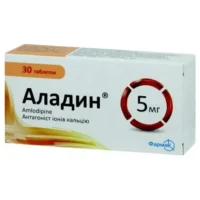Description
Evroramipril N (Ramipril) 10 Tablets 10 mg/12.5 mg. №20
Ingredients
Each tablet contains: Ramipril 10 mg and Hydrochlorothiazide 12.5 mg.
Mechanism of Action
Ramipril is an ACE inhibitor that works by relaxing blood vessels, reducing peripheral resistance, and ultimately lowering blood pressure. Hydrochlorothiazide is a thiazide diuretic that inhibits sodium reabsorption in the distal convoluted tubule, promoting diuresis and decreasing blood volume.
Pharmacological Properties
Evroramipril N combines the antihypertensive effects of ramipril with the diuretic properties of hydrochlorothiazide, resulting in a synergistic action to manage hypertension.
Indications for Use
Evroramipril N tablets are indicated for the treatment of hypertension in patients whose blood pressure is not adequately controlled by monotherapy with either ramipril or hydrochlorothiazide alone.
Contraindications
Do not use Evroramipril N if:
- You are allergic to ramipril, hydrochlorothiazide, or any other ingredients in the product.
- You have a history of angioedema related to previous ACE inhibitor therapy.
- You have severe renal impairment (creatinine clearance <30 mL/min).
Side Effects
Common side effects of Evroramipril N may include hypotension, dizziness, cough, hyperkalemia, and renal impairment. It is important to consult a healthcare provider if any adverse reactions occur.
Usage Instructions
Take Evroramipril N tablets orally once daily, preferably in the morning. The tablets can be taken with or without food. Swallow the tablet whole with a glass of water.
Benefits Compared to Analogues
The combination of ramipril and hydrochlorothiazide in Evroramipril N offers a more comprehensive approach to managing hypertension compared to using either drug alone. This combination therapy provides enhanced blood pressure control and reduces the risk of cardiovascular events.
Suitable Patient Groups
Evroramipril N is suitable for adult patients with hypertension that is not adequately controlled with monotherapy. It may be used in various patient populations, including the elderly, but caution is advised in patients with severe renal impairment.
Storage and Shelf Life
Store Evroramipril N tablets in a cool, dry place away from direct sunlight. Keep the product in its original packaging to protect it from moisture. Check the expiration date on the packaging and do not use the tablets beyond that date.
Packaging Description
Evroramipril N is available in blister packs containing 10 tablets each. Each box contains 2 blister packs, totaling 20 tablets.
Clinical Evidence and Proven Effectiveness
Ramipril and hydrochlorothiazide have been extensively studied in clinical trials for their antihypertensive effects. Combination therapy with these two agents has demonstrated superior efficacy in reducing blood pressure compared to monotherapy. Clinical studies have shown that Evroramipril N provides effective blood pressure control and cardiovascular risk reduction in hypertensive patients.





